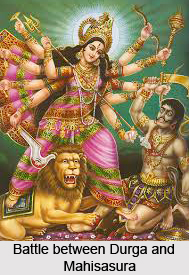 Mahishasura was the leader of the demons who was bestowed with the boon that he could not be killed by any male person. Thus, being empowered he began terrorising the gods and expelled them from heaven. The gods then approached Lord Brahma, Lord Vishnu, and Lord Shiva for help. The trio culminated their powers and created Goddess Durga. They equipped her with weapons. The goddess with her unprecedented powers fought with the demon.
Mahishasura was the leader of the demons who was bestowed with the boon that he could not be killed by any male person. Thus, being empowered he began terrorising the gods and expelled them from heaven. The gods then approached Lord Brahma, Lord Vishnu, and Lord Shiva for help. The trio culminated their powers and created Goddess Durga. They equipped her with weapons. The goddess with her unprecedented powers fought with the demon.
Preparation for Battle
Mahishasura first sent a huge army to fight the goddess. The demon army was easily defeated. The demon king soon called for a meeting where he was advised by Vighasa, a courtier to propose the deity for marriage. Dundubhi, the son of Maya was sent to the goddess with the message. Upon hearing the message the goddess turned down the proposal saying that she would marry accept the person as her husband who would overpower her and shatter her pride. The messenger returned back and narrated the complete incident to the demon king. He soon called for another meeting with his commanders and ministers where they discussed about various means of defeating the goddess. Mahishasura then ordered his commander Virupaksa to organise an army to fight the goddess. A well equipped army was prepared that comprised of almost hundred and nine crores of warriors. They rode on different types of vehicles, flying different flags and exhibited several types of weapons. According to the Devi Bhagavata Purana the chariot of Mahisasura, was driven by thousand horses and had banners and flags hoisted over it. It stored several types of weapons also. Several instruments were also employed when the troops marched towards the battlefield. It included damarus, drums, veena, conches, behri, bells and big drums. The battle is thought to have been fought in the Vindhya Mountain Range, where the goddess was born out of the culminating powers of the gods.
Battle Scene
Various texts have multifariously depicted the horrific sight of the battlefield that portrayed the fierce battle between the goddess and asuras which led widespread bloodshed. The goddess using her powerful weapons such as trident, club, spears, sword and others slay thousands of soldiers whose blood littered the earth. The texts depict the gruesome sight where some of the demons were cut into pieces while others` head were chopped off, some were grievously hurt and others lay dead without some parts of their body. Wounded and dead animals and broken chariots lay scattered in different places.
Mahisasura finally came into direct conflict with the goddess when his entire army was destroyed. He lay low in his buffalo form while fighting with the goddess and attacked her heroically with his weapons. The goddess too displayed her wrath and pounded the earth with caused widespread destruction. The asura in alarm quitted his buffalo shape and took the form of a human being holding a shield and a sword in his two hands. He attacked the lion, the vehicle of the goddess. The asura then again took to the form of a buffalo but the deity cut off the head of the buffalo. The asura half issued from the neck of the buffalo and was then overpowered by the goddess. Having laid him low the deity finally pierced her trident into the heart of the demon and killed him.




















